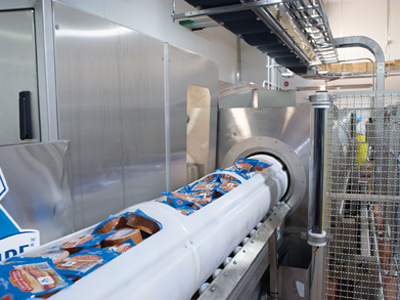
Under Pressure
By Canadian Poultry Magazine
Features New Technology ProductionMaple Lodge discusses its new food safety technology
Maple Lodge Farms recently introduced High Pressure Protection to meet
consumer demands for enhanced food safety. Canadian Poultry Magazine
had a few questions about consumer attitudes, the process and consumer
response.
Maple Lodge Farms recently introduced High Pressure Protection to meet consumer demands for enhanced food safety. Canadian Poultry Magazine had a few questions about consumer attitudes, the process and consumer response.
 |
|
| Cooked and packaged products are loaded into baskets on the conveyer system of the HPP. The basket is loaded into the vessel, it is sealed and then water is pumped in. Water is then pressurized to 87,000 pounds per square inch. Energy transmitted via water pressure to the food inactivates pathogens. Advertisement
|
Carol Gardin, Marketing Manager for Maple Lodge, was kind enough to answer.
Canadian Poultry Magazine (CPM): Polls and surveys in recent years have indicated a growing consumer desire (demand) for safer food. What has been the consumer response to Maple Lodge’s High Pressure Protection™ products? Has the current recession had any impact?
Carol Gardin (CG): A recent consumer survey conducted for Maple Lodge Farms (National survey with more than 3,200 respondents) shows that 92 per cent of consumers surveyed report food safety as a top consideration in their food purchase decision. This is a marked increase over what we have typically seen in the past of around 20-25 per cent. Consumer confidence is still reeling in the wake of the Listeriosis outbreak that occurred last year – as well as several unrelated and subsequent food recalls – and this is a distinct challenge for manufacturers and retailers alike. We have to make serious effort to provide consumers with some tangible evidence that we are doing something significant to ensure the safety of our products. This is why we have chosen to market our High Pressure Protection technology. It is our way of showing consumers that we have taken their concerns seriously and have made a significant investment to provide added assurance to the safety of our products.
Consumer feedback has been extremely positive. We have had customers call and thank us for providing them with a solution to their dilemma of wanting to enjoy the convenience of ready-to-eat meats but at the same time being concerned that they were making a choice that they felt might possibly harm their health. Many have done their own research into what High Pressure Processing is and once they understand, even people who have stopped buying deli meats say they have been willing to try the ones processed this way. Other published research papers demonstrate high consumer acceptance of the process based on the participants’ perception of the “naturalness, improved taste and high nutritional value” of the products processed this way.
 |
|
| Addressing Concerns Carol Gardin, Marketing Manager for Maple Lodge Farms, says that a recent consumer survey conducted by the company shows that 92 per cent of consumers report that food safety is a top consideration in their food purchase decisions.
|
The impact on the end cost of HPP processed products has been only pennies per 100 grams so customers have really not felt a big pinch. The current economy has shifted sales upwards in less expensive items such as bologna and chicken loaves, but there is still a big market for the more premium items. People are still concerned about their health and subsequently are willing to pay a little more for more premium whole muscle products. Today’s consumers want it all – they want nutritious, safe, tasty and convenient products without a lot of additives and aren’t willing to compromise on one to get another. The challenge to manufacturers is to be able to deliver all of these attributes at a reasonable price to the consumer and still maintain profit margins. Our High Pressure Protection technology will allow us to do all of this over the long term and provides us with the immediate ability to offer an added measure of safety to our chicken deli products.
CPM: What does the process/procedure look like? How is that amount of pressure generated?
How is the technology incorporated into a production system/production line?
CG: The High Pressure Processing (HPP) equipment basically is a long horizontal cylindrical vessel, which is housed in a steel frame. Attached is a large holding tank for the water and intensifier pumps, which act to create the pressure in the vessel, all of which are housed in an adjacent room. There is an accessory conveyor system a control centre and a computerized operator’s panel.
Here is how it works:
After the products have been cooked and packaged in our deli plant, the sealed deli products are loaded into baskets on the conveyer system of the HPP. The basket is loaded into the vessel, it is sealed and then water is pumped in. Water is then pressurized via intensifier pumps to extraordinary levels – 87,000 pounds per square inch. To put this into perspective, the deepest trench in the ocean exerts a pressure of around 16,000 pounds per square inch – enough to crush a submarine and most living organisms. High Pressure Processing operates at more than five time this pressure! Energy transmitted via water pressure to the food inactivates pathogens (for example, listeria, salmonella and E. coli) mainly by destroying their cell membranes. In terms of the pressure altering or damaging the product, pressure is applied in all directions uniformly, so it suffers no physical changes – taste, nutrition, appearance and texture all remain intact. Think of a grape placed into a sealed water bottle – no matter how hard you squeeze no damage occurs to the grape. The pressure is applied for a few minutes and then released, water is drained out and the conveyor system rolls the product out. As an added benefit, HPP’d food tastes fresh much longer and shelf life is significantly extended (doubled in some cases) as food spoilage organisms are inactivated at the same time.
High Pressure Processing is an additional and final step in the production of all of our deli items, as well as our chicken bacon. It was a significant investment not only in terms of the equipment and facility expansion, but has also increased the amount of time it takes to produce a finished product.
CPM: Is there potential to expand the use of this technology beyond deli meats?
CG: Maple Lodge Farms is joining leading food companies around the globe who are adopting HPP. A $2-billion business worldwide, commercially available HPP foods include fruit smoothies, guacamole, ready-to-eat meals, seafood, salad dressings, ham, fruit juices, sauces and salsa.
CPM: How does High Pressure Protection technology complement what Maple Lodge is already doing on food safety? If Maple Lodge were to rank its priorities where would food safety be ranked?
CG: Food safety has always been paramount at Maple Lodge Farms. We have always adhered to very stringent sanitation practices, which are key in the prevention and control of pathogens. No measure of intervention – whether antimicrobial or a post-lethality process such as HPP – can substitute for rigorous sanitation procedures. The incorporation of High Pressure Protection technology into our production process provides an additional measure of safety to our products and provides added assurance to our consumers.
Print this page